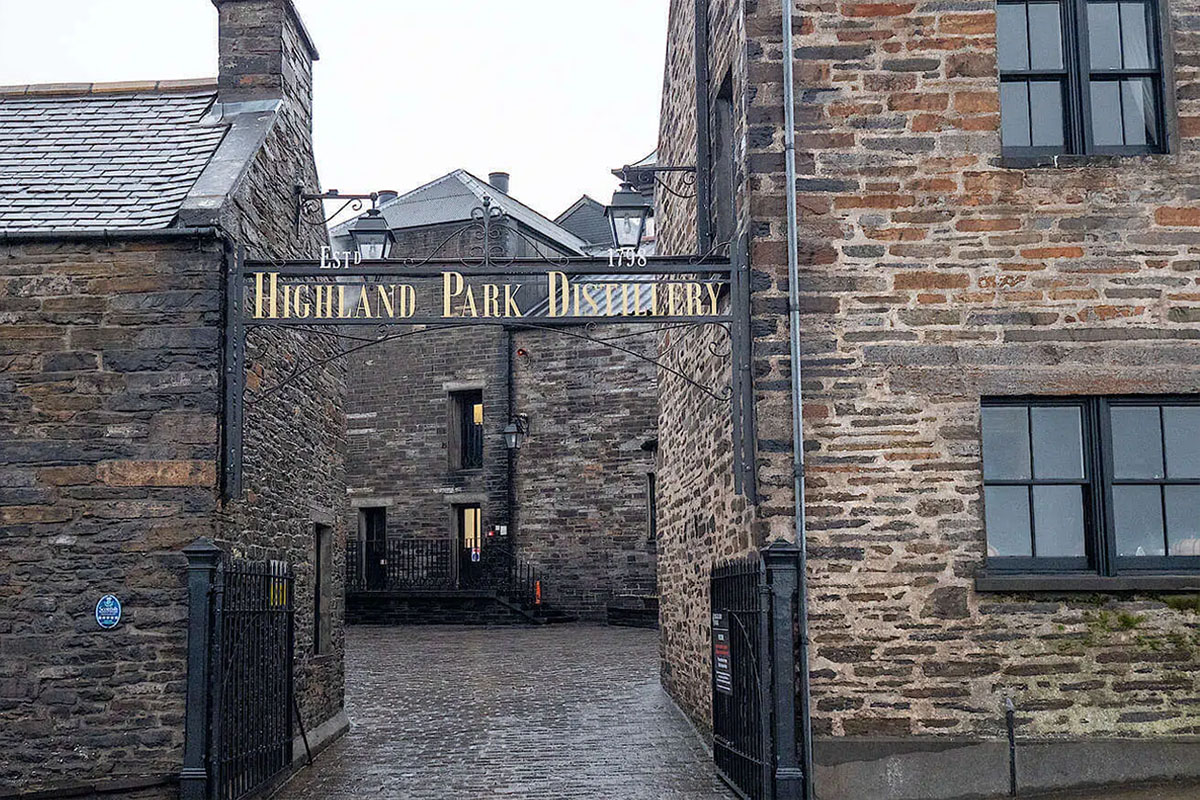Highland Park’s story
For much of its long history, Highland Park was Scotland’s most northerly distillery. This changed when the Lerwick Distillery on the Shetland islands was founded in 2023. Highland Park is located on the main road between the Orkney island’s capital of Kirkwall and the small town of Holm. It is one of a handful of distilleries still in operation that were established in the 18th century and one of another handful that undertake traditional floor malting on site – this accounts for around 25% of their total malt.
The distillery’s location gives the whisky produced there some unique characteristics. The first factor is that the water used in production is from a local spring and is extremely hard. Most distilleries are based close to softer water sources, which is said to be the best style of water for distilling. The second is that the peat on the Orkneys is different to that found in the rest of Scotland, particularly that found on other islands. There are very few trees on the Orkneys, so the peat does not contain any tree roots but is instead made up of mostly decomposed and compacted heather, fern and bracken plants. This means that when Orkney peat is used to fire the kilns and stop the germination of the malted barley, it burns with a lower heat but with more floral fragrant smoke than elsewhere.
This makes Highland Park extremely accessible to all whisky drinkers and presents lovely, soft savoury notes that underpin all other charcateristics within their whisky. This has made Highland Park an extremely popular Scotch single malt brand that consistently sits within the Top 20 for world sales, with around two million bottles sold each year.
Highland Park’s history
Highland Park distillery was established and built by David Robertson in 1798. Taking its name from the High Park spring, which remains as its water source today. It was operated by an interesting character called Magnus Eunson – he was a priest who dabbled in illegal distillation on the side and is said to have hidden his whisky from the authorities in the vaults of his church in Kirkwall.
Eunson, who was nicknamed ‘the whisky priest’, positioned his illicit distillery on the main smuggling road on the island, in order to help distribute his spirit. This was also helped by the fact that Orkney’s capital of Kirkwall was one of the smuggling capitals in the north of Scotland at that time. Due to its remote location, Orkney was very difficult for the police and excise men to get to. Howver, they did finally track him down in 1813 but he escaped prosecution in a way that added to the suspicious nature of the distillery’s early history. His prosecuting officer, John Robertson, agreed to let Eunson go free as long as Eunson sold him the distillery and all the surrounding farmland.
Following the Excise Act of 1823, the distillery got a license to distil and was immediately expanded. Robert Borwick took control from Robertson in 1826, then later in 1840 his son George. By the 1850s Highland Park had built a credible reputation and was releasing a limited range of single malts, which was relatively rare at the time, and supplying some of the biggest blending houses in Scotland with whisky for their brands. These included Ballantines, Chivas and Dewars.
In 1895, James Grant from Glenlivet distillery in Speyside purchased Highland Park. He expanded the distillery and doubled its capacity. Highland Distillers were the next owners and took control in 1937. Their ownership lasted over six decades until the company was purchased by the Edrington Group, with assistance from William Grant & Sons. The Edrington Group are now the sole owners of the the distillery and the current capacity is 2.5 million litres per year. Their focus is on the Highland Park single malt range but the spirit remains highly sought after by blenders – this sees Highland Park as a key ingredient in several blends including Famous Grouse.
Highland Park also boasts one of the most visited distillery visitor centres in Scotland and has been awarded the prestigious five star visitor attraction award by Visit Scotland for many years running. The visitor centre was one of the first in Scotland when opened in 1986.
- How to pronounce Highland Park? hi-land-park
- Country: Scotland
- Region: Islands – Orkney
- Founded: 1798
- Current owners: Edrington Group
- Production capacity per year: 2.5 million litres
- Mash tun: 12 ton
- Washbacks: 12
- Stills: 4
- Visitor centre: Yes
Highland Park Distillery
Holm Road
Kirkwall
Orkney
KW15 1SU
tel – +44(0)1856 874619
www.highlandparkwhisky.com
Did you know?
The Orkney climate is influenced by the Atlantic Gulf Stream, resulting in milder temperatures than other locations on the same latitude. It also makes the islands one of the windiest places in the UK and strong gales are frequent. Over 50 hours of extreme gales are officially recorded each year!
Highland Park


